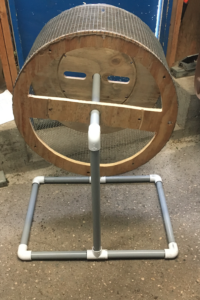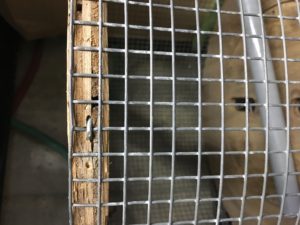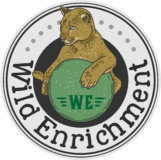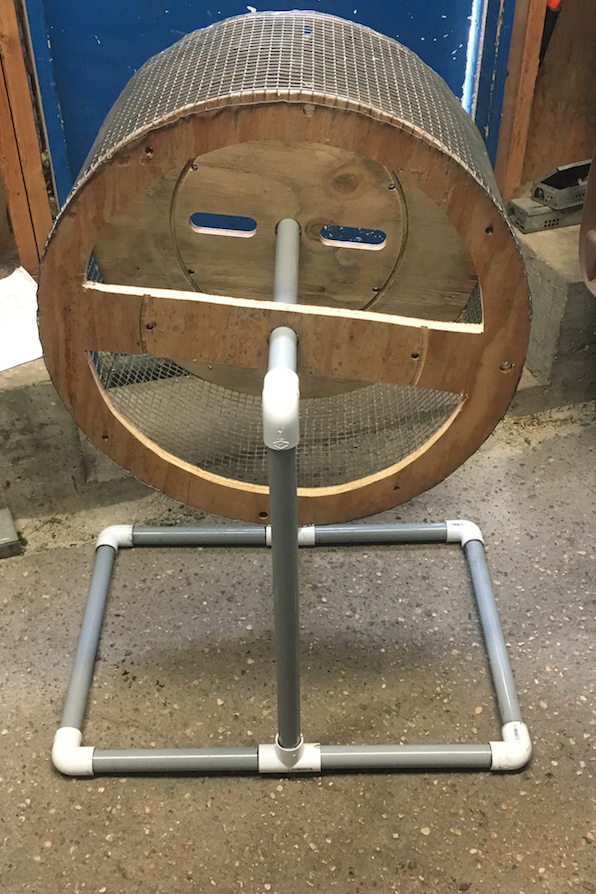 Description:
Description:
This item is basically a large hamster running wheel which can be used as enrichment for small mammals and even birds (and theoretically larger animals if the building materials were made more robust). Since this particular running wheel was only going to be used for small mammals a basic frame was designed using PVC piping and the actual wheel was designed using a broken wooden spool (more spool enrichment) surrounded by wire mesh. Being relatively easy to build this item could be a fun edition to many exhibits!
Building Materials
- PVC pipe or plastic conduit
- 6 PVC Elbows
- 2 PVC T-Junctions
- PVC Pipe glue
- 1/2 x 1/2″ Wire mesh
- Metal sheers
- Wooden spool
- Steel U nails
- Wire
- Jig saw
- Hand Saw
- Tape Measure
- Hammer
- Sand
Steps
- The first step to this build will be dissembling your wooden spool so it is just the 2 circular ends. The size of spool you use is going to depend on the animals you intend to use this enrichment item for. Once you have the two ends of the spool you are going to need to measure their circumference for the wire that will surround the wheel (for those of you that can’t remember grade 7 geometry, the circumference is the distance around the whole circle).
- When you have the circumference measurement you can then decide on how wide you want the wheel to be, this will again depend on the animal you intend to enrich. These two measurements will be the two you will need to cut your wire mesh to cover your wheel once its built, so you can go ahead and carefully cut the wire to those dimensions with the metal sheers.
- You now have everything you need to make the wheel portion of this piece. To start assembling, take one wheel and the end of the wire mesh and line the wire up with the edge of the wheel. Next you can take a U nail and placing it in between two links, secure the mesh to the wheel (see picture below for U nail placement)
 . Grab the other wheel and secure it to the other side of the mesh, continue this process all along the wheel until you reach the end. At this point you can use the wire to secure the end of the mesh back on itself if it is sticking up.
. Grab the other wheel and secure it to the other side of the mesh, continue this process all along the wheel until you reach the end. At this point you can use the wire to secure the end of the mesh back on itself if it is sticking up. - You can then use the Jig-Saw on one side or both of the wheel to cut out an entrance for the animal to get in. To make starting the jigsaw cut easier, start by drilling a hole with a screw driver and carefully tracing out the cut you want to make. Make sure you leave enough material to support the weight of the wheel when it is spinning.
- Now its time to build the stand for the enrichment wheel. This is relatively easy to do as its only made out of pvc. The measurements are all irrelevant here as its really going to depend on what animal you are using this for. Essentially you are going to make a rectangular base with 6 pieces, using 4 PVC elbow’s at each corner and 2 T-joints in the middle of the rectangle.
- Once you have a base you will need to make the upper portion of the stand by placing two long pipes in the T-Junctions. Once you have those you can place an elbow joint on each and one piece in the middle that the actual wheel will sit on.
- If you are happy with the stand, you can then glue the base together as well as the two supporting pipes. Before you finish gluing, take your sand and fill the PVC pipes with it, this will make them heavier to counteract the wheel moving as the animal runs.
- After filling with sand you can finish gluing the stand together, making sure to put the wheel in place.
Tips/ Comments
Although this is a long post, this is a great item for people to attempt as it employs a lot of different skills and you will learn a lot from it! If the stand is still moving when the running wheel is in use you can place rocks or other heavy objects on the base to stop this. If you want to make the wheel a permanent edition to an exhibit you can screw it to the ground or tweak the stand so it attaches to a wall.

